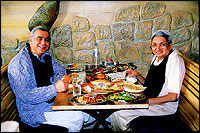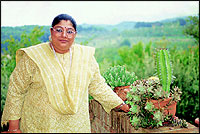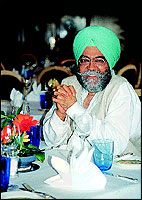


 The Fine Art Of Food Criticism
The Fine Art Of Food CriticismIn between writing serious political columns and interviewing celebrities for television, VIR SANGHVI is both gourmet and gourmand. He is ranked among India's best food writers of today. In his new book Rude Food, he describes the food critic�s role. |
|
WHEN I was growing up in Bombay, there were only two food critics of any consequence. Both went on to become legends. The first was Jiggs (or more properly, Jay Inder Singh) Kalra, who was then the rising star of Khushwant Singh�s Illustrated Weekly but had already begun to demonstrate a great feel for food. When Jiggs wrote about a restaurant, you trusted his judgement. The other was, of course, Busybee aka Behram Contractor.
Behram was Chief Reporter of the old Evening News of India (now defunct), and was regarded by everybody in the trade as the finest reporter in Bombay. To the average reader, however, he was better known as the author of the funny Round and About column on the back page which he signed �Busybee�. It was in this latter guise that he wrote his restaurant reviews and many readers did not � at least not till many years later � work out that Chief Reporter Behram and funny, food-loving Busybee were the same man.
When a restaurant culture did develop, both found success doing different things. Jiggs is today one of India�s foremost culinary impresarios and rarely writes about restaurants. Behram left the Evening News to start Mid-Day, left that to start the Afternoon and still remains, a few years after his death, Bombay�s most famous byline. His wife Farzana has kept the foodie tradition alive as founder-editor of the excellent UpperCrust magazine.
On the other hand, following the hotel and restaurant explosion of the 1980s and the 1990s, we now have a new breed of restaurant critic who is knowledgeable about food and paid to be critical: to tell readers where they should spend their money and what to avoid. Curiously, Bombay has yet to throw up a good restaurant critic. The biggest name is Rashmi Uday Singh who is a food writer in the Busybee mould, more interested in making the food come alive than in running down restaurants. But in Delhi, the formidable Sabina Sehgal Saikia can make or break a restaurant�s business with her acerbic judgements; Sourish Bhattacharya can turn a little-known restaurant into a huge celebrity haunt; and I�m always guided by the fair and accurate reviews that Marryam Reshi writes for HT City.
But food critics face problems of their own.
In the late 1970s, I started writing critical restaurant reviews for the magazine I then edited. I was in my early twenties, entirely unknown and therefore undeserving of any special attention at the restaurants I visited. But within eight months of the start of my reviewing career a funny thing happened.
Each time I would go to a restaurant the manager would rush to my side and lead me to my table, while simultaneously tugging at his forelock. The chef would then emerge from the kitchen and begin genuflecting. He would contemptuously toss the menu aside and promise to cook me a special meal which was based on fresh ingredients, newly flown in from every comer of the world � �entirely off-the-menu, sir�. After each course, five waiters would appear to ask if I�d liked the food. And so on.
Obviously, my restaurant experience bore no relation to what the average guest was going to get.
In 1982, when I resumed writing restaurant reviews for another publication, I used a pseudonym and my editor agreed to zealously guard my identity. This worked much better (the chef never emerged from the kitchen and hotel PR people looked through me) but by late 1983, my cover was blown, at least among the big hotels, and the genuflecting began afresh.
I wondered then about food critics and whether they could ever claim to judge a restaurant fairly. There are, broadly, two approaches to the subject. The first is the traditional French approach in which the food critic sees himself on a par with an art critic or a film critic. When he judges a meal, he is judging a work of art and must treat it as such. Most of the great French food critics have been celebrities and have revelled in being famous.
The official position, as explained by the authors of the Gault-Millau Guide is �it is always possible to get a bad meal in a good restaurant. In fact, it happens all the time. But it is never possible to get a good meal at a bad restaurant.� In other words, even if the chef recognises you, he can�t cook a good meal if he�s a bad chef. This, I suppose, was also the position implicitly adopted by Jiggs, Busybee and all the other famous Indian food critics.
But there is a second view. The red Michelin Guide lists restaurants it recommends (but without any description other than a list of specialities). Some get stars (three stars is tops). These ratings are devised on the basis of several visits by anonymous inspectors who go several times before deciding to award a star. Michelin reckons that this is a more reliable way of judging a restaurant because it more closely approximates what a paying (non-famous) customer is likely to experience.
In recent years, some American critics have agreed. At the New York Times, Mimi Sheraton (who, like Sabina or Marryam, could make or break restaurant) was so paranoid about being recognised that she refused ever to be photographed. In London, the positions tend to vary. Famous food critics (Jonathan Meades, Adrian Gill, etc.) appear on TV so often that they are instantly recognised. On the other hand, the one British critic I always take seriously, Fay Maschler, gets around this problem nicely by printing a picture with her column � the trick is that the photo looks nothing like her. I always thought it was vanity (the photo must have been taken during her childhood) but Fay claims it is a desire for anonymity that motivates her. (That�s what they all say.)
My own view is that there is room for both, the anonymous reviewer and the well-known expert. In London and New York I use the Zagat Surveys which are based on readers� responses, so each restaurant has probably been visited at least a hundred times before the reviews are written. In Delhi I go by Marryam Reshi�s reviews, not only because she is so good, but because she is
largely anonymous.
On the other hand, how would I judge a truly great chef? Would I go by the views of anonymous reviewers alone or would I also be influenced by the praise of an expert like Sabina?
The answer, I suspect, is that there�s no one rule for food critics. If you want to know a good place for an average evening out, stick with the anonymous reviewers. But if you want an expert opinion, then don�t worry about how famous the critic is. In that sense, Gault-Millau are right: a bad chef can�t produce a good meal and to judge a great meal you probably have to read the opinion of the successors to Behram Contractor and Jiggs Kalra.
In other words, if it�s ambience and the total experience you want, trust the anonymous or less famous reviewers. (But always ignore the hype-laden praise of five-star hotels from freebie journos.) Food is an art, and to judge the top end, you do need to read the views of a top critic.
|
|
|

Home Page
About the mag
Subscribe
Advertise
Contact Us

 Both Behram and Jiggs were regular journalists who treated food writing as a labour of love. They flourished in an era where there were few five-star hotel restaurants, no fancy stand-alones and little in the way of non-Indian cuisine. Consequently, they specialised in discovering restaurants, in providing tips and introducing readers to regional cuisines. There was no point in writing bad reviews or commenting on restaurant ambience � India had not yet reached
that stage.
Both Behram and Jiggs were regular journalists who treated food writing as a labour of love. They flourished in an era where there were few five-star hotel restaurants, no fancy stand-alones and little in the way of non-Indian cuisine. Consequently, they specialised in discovering restaurants, in providing tips and introducing readers to regional cuisines. There was no point in writing bad reviews or commenting on restaurant ambience � India had not yet reached
that stage. No restaurant critic has, in the years that passed, ever managed to write with the authority of Jiggs. Nor has anybody managed to write about food with the love and affection that Behram brought to his reviews. Both have remained in a class of their own.
No restaurant critic has, in the years that passed, ever managed to write with the authority of Jiggs. Nor has anybody managed to write about food with the love and affection that Behram brought to his reviews. Both have remained in a class of their own.